Physical Address
304 North Cardinal St.
Dorchester Center, MA 02124
Physical Address
304 North Cardinal St.
Dorchester Center, MA 02124
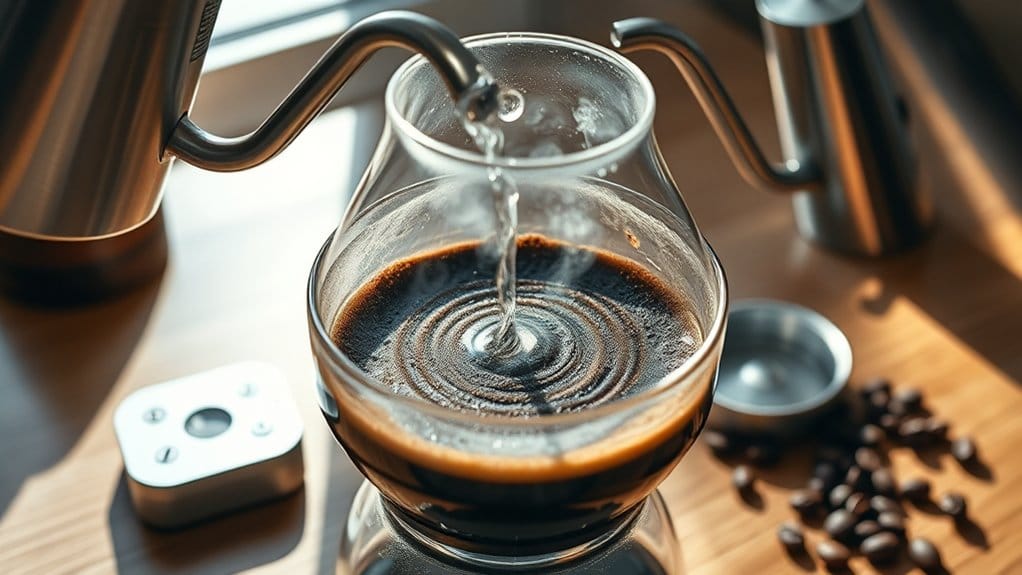
Want to perfect your coffee bloom? Start by using freshly roasted beans. That beautiful foaming you see is CO2 escaping—it’s crucial for flavor. Grab a gooseneck kettle, a pour-over maker, and remember to weigh your coffee. A medium grind works best, and aim for a 1:16 coffee-to-water ratio. Pour slowly in a spiral to let the bloom do its magic! Stick around, and we’ll investigate more tips for brewing that perfect cup.
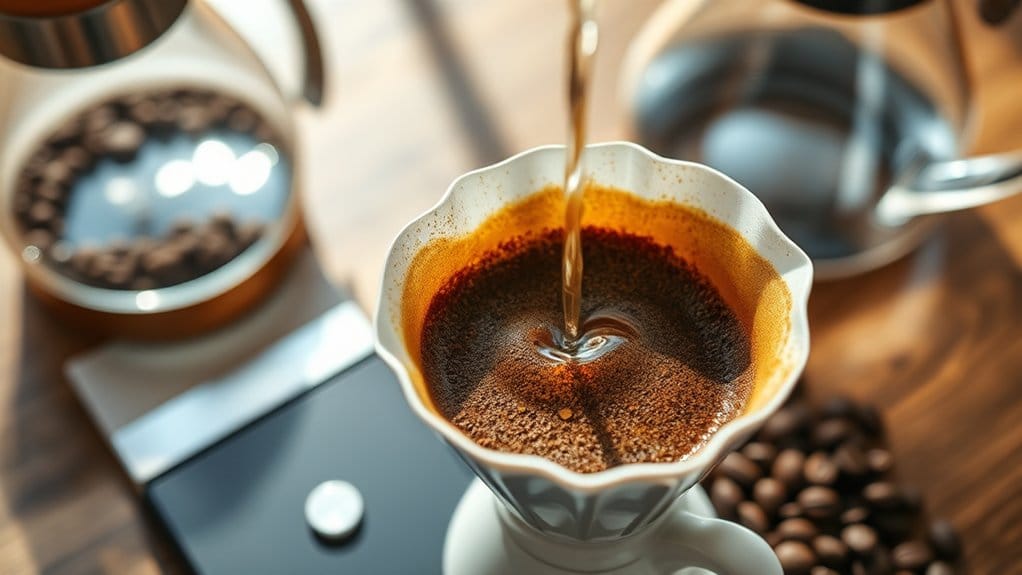
When you brew a cup of pour-over coffee, you might notice something exciting happening right away. That’s the coffee bloom! It’s like a mini volcanic eruption, releasing gases, mainly CO2, from the coffee grounds.
This happens when hot water meets the beans, displacing those trapped gases accumulated during roasting. You’ll see foaming and bubbling, especially if your coffee’s freshly roasted. A strong bloom helps guarantee even extraction, so every flavor shines through in your cup. Blooming occurs primarily with pour-over brewing methods, making it essential for optimal coffee preparation. Understanding that the bloom is a freshness indicator for your coffee can ensure you get the most vibrant flavors possible.
Think of it as waking up your coffee! But remember, how visible the bloom is can depend on the freshness of your beans and the brewing method.
During brewing your perfect cup of pour-over coffee, having the right equipment can make all the difference in achieving that delightful bloom.
First up, you’ll need a solid pour-over coffee maker, like the Hario V60 or Chemex. They both shine with regard to blooming! The Chemex, known for its timeless appeal, is favored by coffee aficionados for its ability to produce a clean and flavorful cup.
Don’t forget a gooseneck kettle for precise pouring—it’s your magic wand. A digital scale is crucial too, ensuring you measure coffee and water accurately. Correct grind size is essential for achieving optimal brewing conditions and can impact your bloom as well.
Use paper filters for a cleaner cup, or go bold with metal filters for richness. Finally, a timer helps track your bloom duration, usually 30 to 60 seconds. Proper blooming is essential as it enhances flavor extraction and ensures a balanced cup, allowing you to fully enjoy the profile of your chosen coffee.
With these tools, you’re set for coffee success. Now, let’s brew something special!
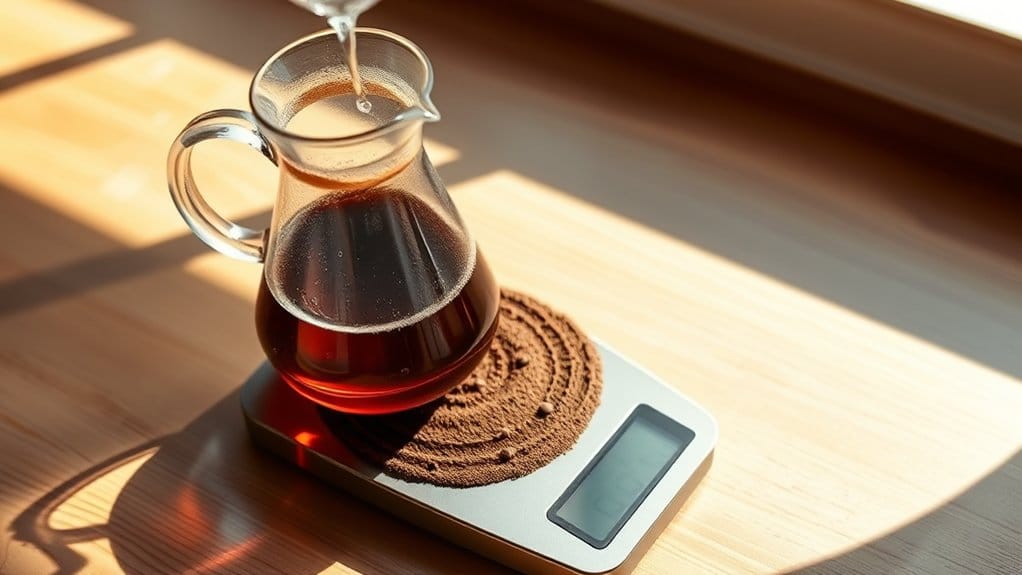
Crafting the perfect cup of pour-over coffee is all about the right grind size and coffee ratio. Aim for a medium to medium-coarse grind, typically in the range of 410-930 microns. This allows for ideal extraction without any bitterness or weak spots. Remember, freshly ground coffee maximizes flavor extraction, enhancing your overall experience. Additionally, using filtered water can significantly improve the taste of your brew.
Now, let’s talk ratios! A good starting point is 1 ounce of coffee for every 16 ounces of water. Feel free to tweak this based on your taste—want a stronger kick? Use more coffee! Enjoy the expedition of experimenting with grind and ratio. It’s like a flavor performance, leading you to your perfect brew. Who knew coffee-making could be so fun?
Getting the water temperature just right can make all the difference in your pour-over coffee. Aim for between 195°F and 205°F, just below boiling. If you go too hot, you’ll likely find bitterness creeping in. Too cool? Well, your coffee might taste weak or sour.
For lighter roasts, crank it up to around 205°F to capture those delicate flavors. Medium to dark roasts do best at about 195°F to 200°F, keeping the bitterness at bay. Be sure to use preheated equipment to maintain consistent temperatures before your brew.
Using a gooseneck kettle? Perfect! It helps you pour precisely. Preheat your equipment and keep your water steady.
A small tweak can transform your cup from “meh” to “wow.” So, are you ready to brew the perfect cup?
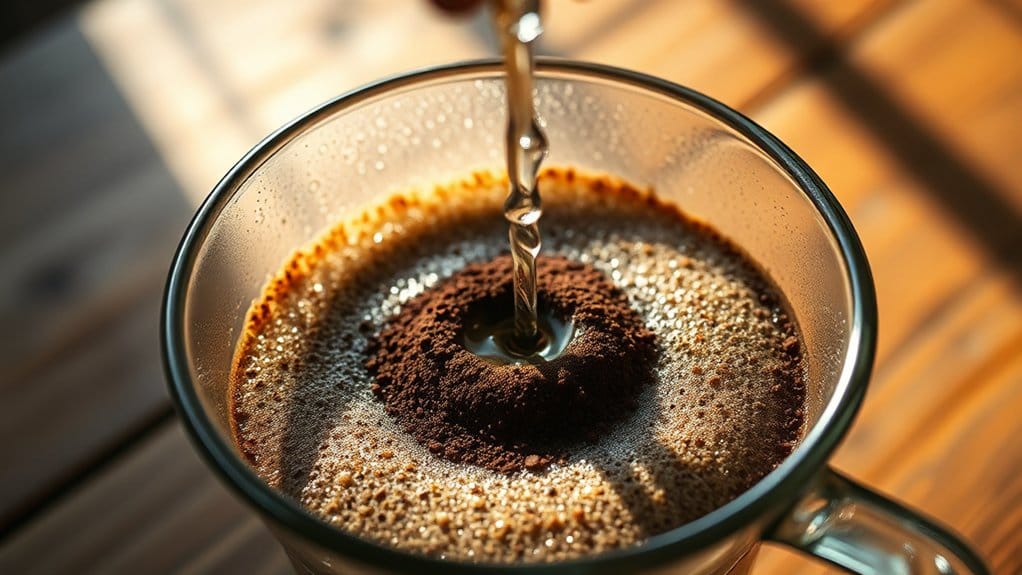
Have you ever wondered why the blooming phase is so crucial in pour-over coffee?
Mastering this technique is the secret sauce to better brews! Start by pouring water slowly in a spiral motion, about twice the weight of your coffee. So, if you’re using 30g of coffee, go for 60g of water.
Watch closely for those little bubbles—that’s the coffee blooming. Timing matters, so give it 45 seconds to a minute. Don’t rush; let that magic happen! If it’s too fast, try a finer grind, and if it’s sluggish, maybe coarsen it a bit.
A gooseneck kettle really helps here. You’ll not only see, but smell, how blooming transforms your coffee into something extraordinary! Additionally, using freshly roasted beans enhances the rich full-bodied flavors extracted during this crucial phase.
Even though you might see blooming as just another step in brewing, it’s actually a game-changer for your coffee experience. Proper blooming improves flavor extraction, letting your taste buds sway with every sip.
By releasing trapped CO₂, it guarantees even water saturation, leading to a balanced, smooth cup. Plus, nothing says “fresh” like a lively bloom! If you catch that bubble, you know your beans are single-origin first-rate.
Blooming additionally creates a uniform coffee bed, reducing the chances of bitter or sour notes sneaking in. With enhanced aroma and flavor complexity, your morning cup transforms into a delightful adventure.
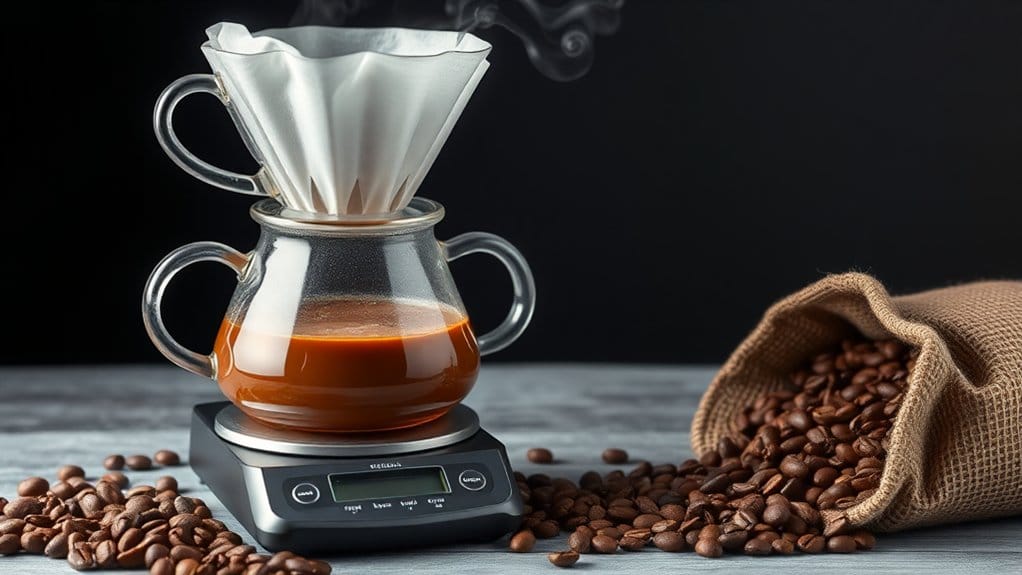
Brewing a great cup of coffee can be as rewarding as the sip itself, but even seasoned coffee lovers can make a few missteps along the way.
First off, be mindful of your coffee-to-water ratio; it should be between 1:15 and 1:17. Using a scale helps keep those measurements precise!
Next, make certain you’re grinding your beans right before brewing for maximum freshness. A medium-coarse grind works best, as it allows for even extraction and enhances the flavor profile.
Don’t forget about rinsing your paper filters to avoid that annoying papery taste.
Additionally, keep your water temperature between 195°F and 205°F for ideal extraction.
And when you’re blooming, take your time and pour evenly to avoid sad, uneven extraction.
Happy brewing—no pressure!
Yes, you can use pre-ground coffee for blooming, but it may not perform as effectively compared to freshly ground beans. To improve results, adjust your pouring technique and amount of water during the bloom stage.
For blooming, you’ll want beans like Ethiopian for their bright acidity, Colombian for balance, or Kenyan for lively flavors. Fresh, light roasts bloom well, but dark roasts shine with more pronounced visual cues.
You can tell your coffee has bloomed properly by looking for foaming and bubbling on the surface. If it lasts 30 seconds to a minute, you’ve likely achieved an effective bloom for ideal flavor extraction.
You can’t skip the blooming step if you want a rich, balanced flavor. Ignoring it may lead to under-extraction, uneven saturation, and a flat taste that lacks the complexity you’re aiming for in your coffee.
Yes, blooming does affect cold brew coffee. By pre-wetting your grounds, you can improve extraction and flavor balance. It helps release trapped gases, leading to a smoother, cleaner taste in your final brew.